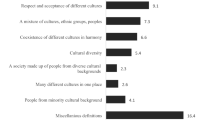Abstract
The purpose of this paper is to introduce North Korean culture as well as its foundation, North Korean cultural policy. The paper consists of three broad sections. First, I explore the unique qualities and changes of North Korean cultural policy. Next, I look into what North Korea considers to be culture and how it is portrayed. Finally, I will analyze the similarities and differences between North and South Korean cultural policy, and the possibility of their convergence.
Similar content being viewed by others
References
Ahn, Chang Mo. (2006). North Korean City and Architecture. In University of North Korean Studies. (Eds.) North Korean Culture: Two but One Culture (pp. 168-205). Paju: Hanwool Academy
Chai, S.S. & Hyon, J.H. (1980). Cultural Policy in the Democratic People’s Republic of Korea. Paris: UNESCO.
Choi, N.S., Baek, M.I. & Ryum, K.S. (1995). An Illustrated Book of Choson Musical Instruments. Pyongyang: Comprehensive Literature and Arts Press.
Han, J.M. & Jung, S.M. (1983). A Study on Literature Theory of Juche. Pyongyang: Social Science Press.
Jeon, Young Sun. (2002). Literature Theory and Operation System in North Korea. Seoul: Yukrak.
Jeon, Young Sun. (2006a). North Korean Literature Theory and Method. In University of North Korean Studies. (Eds.) North Korean Culture: Two but One Culture (pp. 36-271). Paju: Hanwool Academy
Jeon, Young Sun (2006b). North Korean Folk and Traditional Cultural Policy. In University of North Korean Studies. (Eds.) North Korean Culture: Two but One Culture (pp. 235-274). Paju: Hanwool Academy
Kang, Sung Won. (2006). North Korean Paintings. In University of North Korean Studies. (Eds.) North Korean Culture: Two but One Culture (pp. 375-410). Paju: Hanwool Academy
Kim, Jae Yong. (1994). A Historical Understanding of North Korean Literature. Seoul: Munji.
Kim, Jae Yong. (2000). The Structure of the Division and North Korean Literature. Seoul: Munji.
Kim, Jae Yong. (2006). The Flow of North Korean Literature. In University of North Korean Studies. (Eds.) North Korean Culture: Two but One Culture (pp. 275-299). Paju: Hanwool Academy
Kim, Il Sung. (1982). Selected Works. Pyongyang; Choson Labor Party Press
Kim, Jong Il. (1992). A Theory of Juche Literature. Pyongyang: Choson Labor Party Press.
Lee, Chae Hyun. (1999). A Handbook of Choson Artists.
Lee, Hyang Jin. (2000). Contemporary Korean Cinema: Identity, Politics and Culture. Manchester: Manchester University Press.
Lee, Ki Ju. (1991). Great Leader Kim Il-sŏng ’s Leadership of Literature and Arts. Pyongyang; Literature and Arts Press
Lee, On. Juk. (1988). A Study of the North Korean Society. Seoul: Seoul National University Press
Lee, U. Y. (2006). Differences in Culture between South and North Korea. In University of North Korean Studies. (Eds.) North Korean Culture: Two but One Culture (pp. 447-473). Paju: Hanwool Academy
Lee, U. Y. (1994). A Comparative Study on Cultural Policy between South and North Korea. Seoul: Korea Institute for National Unification.
Min, Kyung Chan. (2006). North Korean Music. In University of North Korean Studies. (Eds.) North Korean Culture: Two but One Culture (pp. 347-374). Paju: Hanwool Academy
Oh, Y. R. (1997). A Comparative Study on South and North Korean Cultural Policies. Doctoral Disertation. Sungkyunkwan University Seoul:
Oh, Y. R. (2006). North Korean Cultural Policy. In University of North Korean Studies. (Eds.) North Korean Culture: Two but One Culture (pp. 72-126). Paju: Hanwool Academy
Park, Yung Jung. (2006). North Korean Performing Arts. In University of North Korean Studies. (Eds.) North Korean Culture: Two but One Culture (pp. 411-446). Paju: Hanwool Academy
Portal, Jane (2006). Art Controlled Under North Korea. Chicago: The University of Chicago Press.
Portal, J. (2004). Some Reflections on Art in North Korea. In Portal, Jane & Beth McKillop (eds.). North Korean Culture and Society (pp. 13-22). London: The British Museum.
Portal, Jane & Beth McKillop (eds.). (2004). North Korean Culture and Society. London: The British Museum
Suh, J. (2001). From the Food Shortage to the IT Industry: Changing North Korea. Seoul: Mirae Inryuk Institute.
Tennant, Agnita. (2006). Impressions of North Korean Literature Today: the Unification Theme. In
Acknowledgement
It is quite a mind blowing experience to investigate and make sense of the North Korean issue through their culture and its formation. Since it was not a conventional way of approaching North Korea, there had been some analytic difficulties and challenges. However, with a lot of my kind colleagues’ and students’ dedicated support and passion, it has been a memorable experience for me to conduct the research, write the manuscript and finally finish them. I especially thank Mr. Sang Hoon Lee who graduated from Cornell University, and currently serving the military duty in Yonsei University, for helping on this manuscript. Mr. Lee has extensive knowledge about North Korea, and showed great passion for this particular piece. I again thank him for his dedication and will to finish strong. Also, special thanks to Cornell Undergrad student, Sinclair Kim for adding ideas from U.S. perspective and proof reading the manuscript. Despite his relatively younger age, his academic maturity and determination to participate really impressed everyone involved with the paper. I am also most grateful to J. Ariel Jeong, a graduate student at Tokyo University for collecting extensive data, she has not only contributed the collection of the invaluable data, but also, helped me to carve and refine my ideas through thoughtful conversations. Finally, I will have to thank to all the North Korean interviewees who were kindly willing to do interviews.
Author information
Authors and Affiliations
Corresponding author
Rights and permissions
About this article
Cite this article
Jeong, C.H., Lee, S.H. Cultural Policy in the Democratic People’s Republic of Korea. East Asia 26, 213–225 (2009). https://doi.org/10.1007/s12140-009-9080-5
Received:
Accepted:
Published:
Issue Date:
DOI: https://doi.org/10.1007/s12140-009-9080-5




